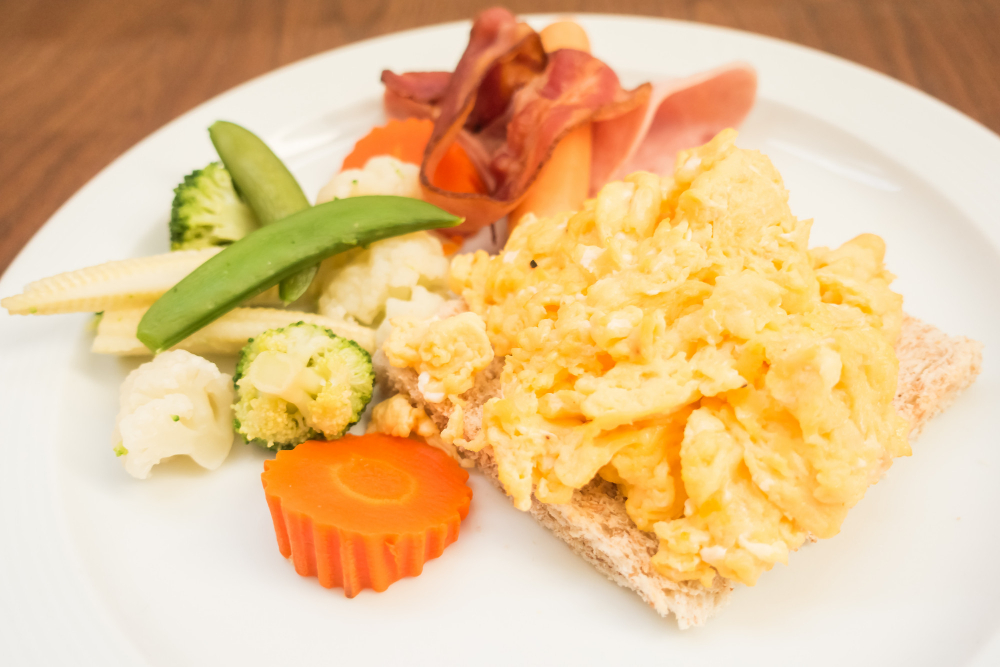Save This Recipe
Let’s just be honest for a minute—scrambled eggs seem so simple, don’t they? Almost laughably so. You crack a couple eggs, toss ’em in a skillet, give ’em a stir, and, presto, there’s your breakfast.
But if you’ve ever wound up with eggs that were rubbery, sad, a little soupy, or some weird shade of hospital beige, you know the truth: scrambled eggs are straightforward… but not always foolproof.
Here’s the lovely part: with a few tiny adjustments—seriously, most of these barely add a minute to your morning routine—your eggs can go from “fine, I guess” to “are you sure you didn’t order these from brunch down the street?”
So whether you’re feeding your favorite people on a drowsy Sunday, making breakfast for one, or surprising someone who usually says they “aren’t a breakfast person,” these tips will help you serve up scrambled eggs that are fluffy, rich, and comforting—every single time.
1. Use Fresh Eggs – It’s Not Just a Snobby Chef Thing
Fresh eggs honestly make a world of difference. And it isn’t just foodie nonsense (I promise). Of course they do taste better, but what you’ll really notice is the structure. Those just-laid eggs have firmer whites and yolks bursting with color, which means your scramble will set up so much nicer—and they’ll look downright gorgeous on the plate too.
Unsure if your eggs are still in their prime? There’s a little trick for that. Just pop one into a bowl of cold water:
-
If it sinks and settles flat at the bottom, you’ve got yourself a super fresh egg.
-
If it stands on one end, it’s still good for scrambling, but it’s on the older side.
-
If it floats to the top, go ahead and thank it for its service and toss it out. At that point, it’s more science experiment than breakfast (ask me how I know).
Farmers’ markets and friendly local farms are my go-to for eggs that are probably fresher than anything in your grocery store. After you’ve tasted the difference, you might have a hard time going back to those dusty supermarket cartons that have seen way too much of the inside of a fridge.
2. Whisk Like You Mean It
This tip is one of those things that seem too trivial to matter… but trust me, it absolutely does.
You really need to whisk those eggs—like, don’t hold back. You want to beat those yolks and whites until they’re fully mixed, but don’t stop there. Whisking brings in a bit of air, and that’s what makes scrambled eggs soft, a little pillowy, and almost cloud-like.
I like to pretend I’m fluffing one of the throw pillows on my sofa. You’re making things light, not just mixing for the sake of it. Use a sturdy fork or, even better, a balloon whisk, and go at it until everything is a sunny, even yellow and just a little frothy on top.
Some people pass their eggs through a fine mesh sieve at this point, especially if they’re after that ultra-silky French style. But honestly? A good, vigorous whisk will get you almost all the way there. (And if you forget the sieve in the back of a high cupboard for two years, I won’t tell anyone.)
3. Add Dairy… Or Don’t. Here’s the Truth.
Now, this is the debate that’s started more than one early-morning argument in my kitchen: should you add milk to your scrambled eggs?
The quick answer: it depends on the mood you’re in. There’s truly no wrong answer here—just a style for every kind of morning.
-
Milk gives your eggs a slightly softer, more spreadable texture. Perfect if you like to pile your eggs on toast or scoop up every last bit with a piece of crusty bread.
-
Cream is pure decadence—your eggs will turn out rich, almost custardy, and dare I say, a little bit luxurious. Great for lazy Sundays when you want to treat yourself (or someone else).
-
Water? Don’t laugh—adding a splash actually makes eggs lighter and gives them extra fluff. The water turns to steam as the eggs cook, lifting everything up a touch.
-
Nothing at all? You do you! Sometimes pure eggs-only flavor is the best thing on a plate.
So which should you reach for? Totally your call. Craving something a little indulgent? Use cream. Looking for a fresh, clean breakfast with herbs from the garden or a handful of sautéed veggies thrown in? Skip the dairy or go for a splash of water. Trust your cravings—after all, you know what makes your own mornings feel special.
4. Low and Slow—Yes, Even When You’re Hungry
This one is a challenge, especially when your stomach’s rumbling and you just want to eat—but I’m telling you, it’s essential.
Scrambled eggs need low heat. High heat is basically their arch-nemesis.
Cooking eggs gently, over medium-low or low heat, coaxes them into soft, creamy curds that practically melt in your mouth (instead of making you reach for an extra gulp of coffee to wash them down). Think of it like stirring risotto—slow, meditative, and more satisfying than you might expect.
I always use a nonstick skillet or my beloved, well-seasoned pan, and a soft spatula or wooden spoon. As the eggs start to come together, I gently fold them over instead of going wild. You’re not looking to whip them around (unless you’re cleaning up after a toddler who insists on “helping”—again, ask me how I know). You’re helping those fluffy eggs along, nice and easy.
5. Fat Is Your Friend—Butter, Ghee, or Olive Oil
Butter does more than just taste wonderful (though yes, that’s a perk). It helps those eggs cook evenly and keeps your pan from turning into a nightmare to clean. And the way it browns gently when you first drop it in? Heaven. Pure, comfort-food magic.
But if you can’t have dairy or just want to try something new, there are other fats that work beautifully:
-
Ghee adds a gorgeous, nutty richness and has a high smoke point, so it won’t burn as quickly if the phone rings and distracts you mid-cook (whoops).
-
Olive oil is a different kind of delicious—savory, a little peppery, and pairs so nicely if you’re topping your eggs with fresh herbs or roasted tomatoes.
Be generous with your butter (or ghee, or oil). Let it melt and start to foam gently—not sizzle or brown—before you pour your eggs in. That’s when you know the pan’s ready for action.
6. Pull Them Off Early—Seriously, Trust the Process
This is one of those tips you only truly believe after overcooking a few too many eggs: if your eggs look done in the pan, they’ll be overdone by the time you sit down.
Eggs cook so quickly, you blink and suddenly everything’s firm and dry. Plus, they keep cooking from residual heat even after you move the pan off the burner (I’ve learned this the hard way, with coffee in one hand and disappointment in the other).
The trick is to take them off when they’re still slightly glossy, just a smidge soft, and maybe even a little too underdone for your instincts. By the time you pour your coffee or reach for the salt, they’ll finish cooking themselves to perfection—soft and creamy, not stiff or crumbly.
This one little adjustment will change your scrambled egg game on the very first try. I promise you, you’ll wonder why you ever settled for “just okay” before.
7. Season Like You Mean It—But Time It Right
Salt seems like a no-brainer, but eggs are surprisingly picky about when you add it.
If you salt the eggs before or while you’re whisking, they can turn out watery, especially if those eggs aren’t farm-fresh or you’re cooking them quickly. Salt too late—like when they’re already on the plate—and it just sits on top instead of working its magic inside.
What you want: add salt (and pepper, if you like) right as the eggs start to set in the pan. Sprinkle, then stir. The seasoning will blend in perfectly, enhance that creamy texture, and help lock in flavor without losing too much moisture.
Feeling a little fancy on a Tuesday morning? Feel free to finish with a sprinkle of flaky salt or a twist of black pepper after cooking. Maybe even a dash of smoked paprika or a bit of garlic powder right before plating—your kitchen, your rules.
Bonus: Let’s Talk Toppings (Because Why Not?)
Once you’ve nailed those luscious, creamy eggs, you might want to jazz them up. A few special finishing touches go a long way:
-
Fresh chives or thin-sliced scallions—bright and herby
-
A sprinkle of feta or goat cheese—just the right amount of tang
-
A drizzle of chili crisp or a hint of truffle oil if you’re feeling adventurous (or hosting brunch, no pressure!)
-
Microgreens or a handful of arugula—a little green always looks pretty, doesn’t it?
And if you’re tucking your eggs into a breakfast sandwich? Try a thin swipe of Dijon or a pile of tangy pickled onions. It’s those little extras that make a regular breakfast feel a bit more special.
So, Are Scrambled Eggs Just Eggs? Or a Whole Mood?
You know what? Scrambled eggs aren’t just something to eat. They’re comfort food, plain and simple. They’re their own little ritual—the scent wafting through the house on a Saturday morning, a plate passed across the table, a “hey, I made this just for you” kind of feeling.
Sure, you can rush them out and end up with something edible. But when you slow down and try even a couple of these tweaks, you’ll get eggs that feel like more than breakfast.
They feel downright luxurious. Like a treat you gave yourself—especially on a day when nothing else is going quite right (again, ask me how I know).
So go on—whisk with a little extra energy, cook just a bit more slowly, and maybe hum along to your favorite song while you stir. You aren’t just making scrambled eggs.
You’re making a cozy moment. And sometimes, that’s all we really need.

